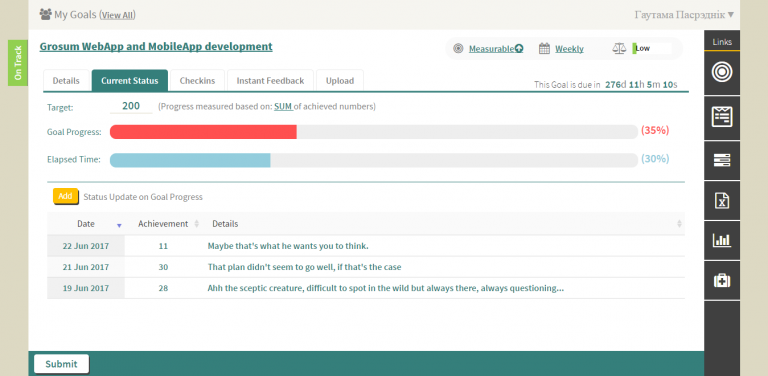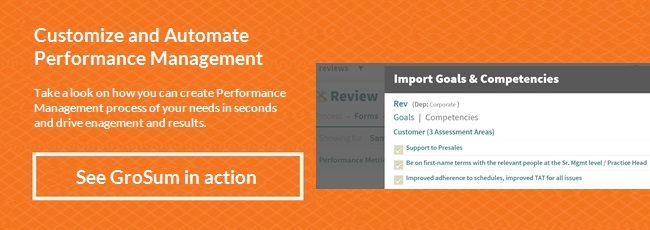
Have you ever wondered why people make new-year resolutions or set targets before they set out to work? Or have you ever thought why some are capable of ticking off all after goal setting and some give up after struggling?
It’s simply because goal setting makes the dream seem achievable and motivates you to increase your efforts.
Imagine fuelling an airplane engine, taking off and not knowing where you are headed mid-air. Chances are you will either run out of fuel or tire out to stop before reaching your desired destination. On the flip side, imagine setting a destination, fuelling the tank accordingly and setting a time frame. This will ensure you reach your destination on time with enough fuel.
There are a dozen blog posts and write-ups talking about the importance of setting goals. But like individuals, goals are also unique and one strategy will not cater to all. In this article, I will be highlighting the importance of effective goal setting. What’s more? I will give you some amazing tips on how to set goals the SMART way.
What does Goal Setting mean?
What do goals mean to you? The word “goal” may immediately draw up a picture of a football match in your head. However, goals hold a wider meaning when they form part of the management literature. In simple terms, a goal is something you aim for.
Goal setting is understood as the process of defining these aims and objectives with certain guidelines to help you achieve the set goals. According to Wikipedia, Goal setting involves the development of an action plan designed to motivate and guide a person or group towards a goal. This definition is perfect for it highlights the two main aspects of goal setting, that is, action plan and its end agenda to motivate.
Imagine yourself in the gym, performing continuous circuit training sets, your goal may be to complete four such sets. After three sets, you feel like giving up but because your goal is set at four, you will feel the drive to push yourself and complete the fourth. And if you perform with a group, the performance, and completion of your goals will inspire and motivate others to complete theirs by putting in that extra bit of effort.
The same process takes place at your workplace. You set a goal, you create an action plan to achieve it and this motivates you and your team to complete the work set. Seems simple right?
However, a lot of people struggle with devising a plan to reach their goal. They know what is to be done, and they are ready to put in an effort to achieve it but they don’t know how to devise an effective plan.
Ultimately, throwing darts in the dark may hit your target by fluke one time, but will eventually lead to failure. So, the first thing to do is reduce the distance between the effort and target by creating a solid plan of action.
Thus, it goes without saying that you need to practice goal setting to define your win.
What are the Benefits of Goal Setting?
It’s easy for me to harp on you to set goals. At the same time, it’s unfair to expect you to do so, without sharing the benefits which come with it. The world of labor study shows a direct and high correlation between employee’s motivation and goal setting. Which employer doesn’t want motivated employees?
Nowadays many organizations acknowledge the importance of motivating their employees for the sheer boost in performance and work culture. Setting clear goals is likely to drive your employees for they will remain engaged in order to reach the goals.
1. Acts as a compass for your business
A ship requires a direction and efforts of the crew to reach the port. Similarly, a business requires a vision backed by actions to succeed. Goals are an intermediate step to perform the right actions. Having a broad plan and vision lays the foundation, breaking it into achievable goals helps build the company.
Also, setting goals makes it easier to prioritize and star mark work.
2. Increases Motivation
Reaching our goals, makes us feel happy. However, setting our goals and falling short to reach them makes us feel equally miserable. According to Prospect theory, this feeling of “short-coming” hurts people more than the feeling of happiness experienced as a result of success. Thus, imagine you and your employees have goals set, and you fail to reach them for xyz reasons. You are more likely to be motivated to put in extra effort in order to avoid the negative feelings.
3. Reduces Stress in the Workplace
Imagine you study all subjects in a year and are required to take exams without knowing the schedule or required marks to pass. Sounds absurd and stressful right?
Goal setting ensures that the focus of employees and managers are focused on essential tasks. It guarantees smooth transitioning between projects and weekly targets.
In fact, a balanced set of goals also improves the efficiency of employees by reducing monotony in work. All these contribute to higher productivity, better profits and automatically lesser stress.
4. Improves Employee Engagement
A study found that employees with clear goals worked faster and more efficiently irrespective of the money factor. This is simply because goal setting keeps them motivated by adding to their feeling of achievement. It also makes them feel important when they schedule their own targets and complete it.
A no-brainer would be to combine both and keep rewards as incentives when an employee reaches a goal.
This list of benefits is not an exhaustive list, goal setting has its own advantages for your employees, team, and company as a whole if done effectively. This makes goal setting a major instrument for attaining a highly productive and driven team.
What is the flip-side of Goal Setting?
Undoubtedly goal setting will improve performance. However, like everything it comes with a flip side. Here is a list of some things which may wrong:
1. Builds Pressure:
Giving your employees targets is the way forward. However, understanding their strengths and weaknesses before setting goals is equally important. Setting unrealistic and vague goals will create pressure, and ultimately affect your employee’s performance.
2. Tunnel Vision:
Setting goals and meticulous planning often take away the focus from the bigger picture. Often managers are so busy setting goals, and employees are engaged in the execution of goals, that the company’s aim and vision are sidelined.
Another issue with tunnel visioning is that the effects of the goals are not taken into account. For instance, launching a new product may be the new goal, but you are so engaged in the conception that you fail to realize the customer’s preferences and needs.
3. Takes a toll on ethics:
Usually, goals are followed by incentives and appraisals. The employees in this run, succumb to unethical practices. They try to achieve the goals by hook or by crook. This may improve profits for a short run, however, in the long run, the company image gets tampered.
4. A sense of failure:
In a team, if an individual cannot reach a goal, he may feel disappointed and depressed. The reason for his failure may be that the goal set for him wasn’t his strength area. This feeling of failure will eventually lead to disengagement and decrease in performance.
How do you classify goals and why?
In an organization there a million things to be done by hundreds of people. It’s very important to have a vision and direction in mind, but how do you execute? Goals are the way to do it.
But hundreds of people, and a million things and only setting goals? Sounds tedious, and reeks of mismanagement, right?
That is why it becomes necessary to classify your goals and plan your objectives accordingly.
So, what are some categories of goal setting which you can use?
Here I have curated a list of six:
Strategic Goals
As the name suggests, the strategic goals are directly related to the mission of the company. When you have plan goals for market standing or maybe implementing a new idea, these will come under strategic goals. Also, these goals are set for the entire organization and not individual departments.
Did you know?
You reading this article, and trying to implement goal setting in your organization itself is an example of strategic goals.
Tactical Goals
These are the next level of goals directly related to strategic goals. They are like support systems for the strategic goals. The goals will include performance parameters for different departments and divisions.
So, if you decide to launch a new product then the break down of which department will do what will consist of your tactical goals. Tactical goals are relatively short-term compared to strategic goals.
Operational Goals
Operations literally mean ready for use. Pertaining to this, operational goals means goals which are ready to implement. Operational goals are thus, specific to subdivisions and employees of the organization.
The setting of individual targets in accordance with a timeline will cater to the operational goal setting.
Super-Ordinate Goals
Have you heard of the idiom “Killing two birds with one arrow”?
A super-ordinate goal is that arrow. It helps in solving two major problems faced- Team building and Conflict resolution.
Setting goals at levels may lead to a clash and eventually conflicts. Super-ordinate goals are setting goals for more than one division. In this, two or more divisions work together towards a common goal, which helps tackle feelings of animosity and tensions in the organizations.
Subjective Goals
These are goals colored with personal preferences and biases. A company which envisions to create a difference in the environment may prioritize using recyclable material irrespective of the costs. Whereas, a company which is focused on creating the best customer satisfaction may prioritize materials which reflects the demands of their customers.
Measurable Goals
Imagine a world where there are no numbers. A world like this will stagnant as there will be no way to measure progress and achievements. And stagnation and success are antonyms.
It is thus, essential to set specific goals which can be measured. If today I ask you what is your sales target for the month?
The answer cannot be to get a lot of customers. The answer should include statements like, “Increase customer acquisition from 10% compared to last quarter” or “Target to convert a thousand leads into customers”
Another way to classify goals would be personal goals. The manager may set individual goals. But when employees break down the task and set sub-goals for themselves it makes them more engaged and productive.
What is the difference between Measurable and Subjective Goals?
I am quite sure that you think both are mutually exclusive sets. However, this is not true.
Subjective goals are intangible and difficult to define because of individual differences. However, they are the backbone of the measurable goals. A company has to have a vision, ethics, preferences, and idea. These form the subjective goals. What ethics will be practiced? Which idea is a priority for the company? What will make the employees happy? What new product is to be launched? Etc, etc.
Once these are set in place, the measurable goals can be formulated. These are specific, and number based. Most importantly measurable goals can be compared and be used to understand the direction your company is heading into. How many vendors will you approach for sourcing materials? How many employees are needed to complete the project on time? When will you interview them? Etc, etc.
It’s clear that there are no black and white categorizations for goals. One goal which seems subjective may transform into a measurable goal as soon as the activity is benchmarked.
How to get to the nitty-gritty of Goal Setting?
It’s very easy to think of an idea or goal to accomplish, and equally difficult to implement it. In order to make sure that you reach your goal, it’s important to make sub-goals, transcend your goals into action plans, get a performance indicator in place and finally, evaluate your accomplishments.
What are sub-goals?
Each goal is an accomplishment. And let’s face the reality, it’s difficult to tick off goals. It requires a lot of time and effort. So how do you keep yourself and your team motivated? How to achieve the goals?
It’s simple. Start small. If the marathon is for five miles, set a goal to complete the first mile, then the next and so on.
Like Lao Tzu said, “The journey of a thousand miles begins with a small step”. Sub-goals is exactly this. It is fragmenting the mammoth tasks involved in the goal into small sub-goals.
Why are sub-goals important?
Say you want to lose five pounds and get healthy. You set your goal to shed the extra pounds in a month. In a week, you feel demotivated you are nowhere near to your goal. What will you do?
Chances are the month will turn into years and you will still not have achieved your goal. This is because the motivation drops gradually.
Now say, in this goal of shedding the extra pounds. You make a weekly target to lose a pound a week and consequently take measurements each week. The first week you lose one, next week you lose half, then again you lose one and so on. These small changes and accomplishments will help you reach your ultimate goal.
Thus, sub goals become important to keep the drive and motivation rising and in place.
How to transcend goals into action plans?
Once you set your goals, your next step should be to hustle. Before you dive into work, it’s essential to define a plan. Because smart work is what creates the magic with Millenials today. Your action plan should be the step by step guide on how to turn your dreams into a reality.
Each action which you put in this plan should include the following elements:
- What changes will take place because of the action?
- Who is accountable for this action?
- When should these activities be completed?
- What additional help will these actions require in terms of resources?
- Who will be affected?
With this in mind, it is also important to create action plans so that nothing and no-one is overlooked. Smartsheets is a great tool to use for making action plans.
Why are action plans important?
In an organization, meticulous planning is of utmost priority. This is because successful businessmen understand that “People don’t plan to fail, instead they fail to plan.”
The next step is to understand if the plan was a success or a failure. The key performance indicators can be used for this purpose.
What are Key Performance Indicators?
It is an indicator used to measure the success of an objective in an organization. It is used at various levels to keep track of the performance of teams and employees. It is the “key” to evaluate the performance as it focuses on specific goals.
Often companies adopt the available KPI’s without any thought. If you do this, likely you won’t be seeing any results. This is because one major function of KPI is communication. And the style of communication in your organization may be different than the industry-recognized KPI which you have adopted for your office.
The KPI’s are losing popularity. The best selling author and enterprise performance expert, Bernard Marr, wrote an interesting article about “What the heck is a…KPI?“. This article highlights that a KPI is only as valuable as you make it.
How to design a KPI for your organization?
Designing a KPI can be complicated.KPIs are often used synonymously with business metrics. It may be used on the same platform, but these need to be formulated according to specific business objectives. Here, is a list of steps that should be followed:
- What is your end outcome?
- Why is this outcome important?
- In what ways can you measure this outcome?
- Can you influence the outcome in any way?
- Who is accountable for this outcome?
- What defines the achievement of this outcome?
- How often does this outcome need a review?
As an example, let’s say your objective is to decrease your attrition rate. Let’s call this KPI your Attrition Rate KPI. Here is an example of you can define it:
- To decrease attrition rate by 10% this year
- Achieving this will help the company be more credible and productive
- Progress will be measured as a decrease in the number of employees leaving the company.
- By conducting more employee engagement activities, by improving incentives provided to the existing employees
- The Human Resource Manager is responsible for this metric
- Attrition must have reduced by at least 10% this year
- The KPI will be revised every three months
How to Set Goals?
Now that you know that goal setting is a major ingredient for your recipe of success, let’s see how can you set goals effectively? What steps are to be followed? How can you implement and make these goals a reality?
These seven steps will guide you to set and achieve your goals.
1) Set an Objective
Setting an objective is equivalent to aiming at the bullseye while playing darts. It’s a way to define what you want to achieve through the goal.
For this an understanding of the company’s vision is important. For then you can align your objective, goals and action plans with the bigger picture.
A long-term vision about the future direction helps in defining objectives. Assessing the current level of where you stand and what needs to change to reach the future ideal scenario is also a great way to set objectives.
2) Make Priority buckets for Tasks
Now that you know what your target is, it will be easier to sort and label tasks as important and not so important. You can make this into a fun team building activity. Call a meeting, have tasks written on sticky notes, make two columns on the wall and start pinning them under important and not so important. Ask each member to sort their tasks using the same wall and columns in the meeting.
So, this way you can list out the urgent tasks and also have a view of which task is directly helping in achieving the set goals.
3) Create A Detailed Plan
You should have a basic idea of how to reach your goal. It’s useful to use mind maps and flow charts to understand the flow of actions required to accomplish your objective.
Once, the basic idea is set, you can use action plans with detailed divisions and timelines for specific actions and sub-goals. Then, it becomes important to cascade the goals from the top down to all levels.
4) Keep provision for Feedbacks
A manager alone cannot be expected to understand the strengths of each employee and devise plans. It’s important for everyone to take part when the time comes to define goals. For this, a provision should be in a place where the employees and managers can give suggestions. And after the plan is executed, their feedback is also equally important to evaluate the efficiency of the plan.
5) Encourage Self-Motivation
Imagine you set a list of things to do for your team, but they aren’t enthusiastic about the goal at all. Or, you may be using a lot of your time by reshuffling and reassigning goals. It may happen your goal setting is top-notch yet employees are not involved with it. To avoid this, it’s mandatory to keep your employees motivated and incentivize proactive behavior. Make yourself and your employees believe that this goal is a stepping stone to your success.
6) Use Time Wisely
Vaguely setting goals with indefinite time will never yield results. Time is one of the primary reasons people fail to achieve their goals. The goal set has to be time-bound, and the employees need to be educated about time management. Using schedules, timelines with priority labels is a great way to go about it.
7) Track Your Goal
After you set a goal, the next important thing is to track your progress. It’s easy to ask your employee to get more customer, but it is important for you to follow up and see the progress.
This helps your employee feel that his work is making a difference, and also, helps you tweak the goal according to needs. Sometimes it may be difficult to keep track, but this can be tackled by continuous communication between you and your team.
If you follow these seven steps, I can guarantee effective goal setting for your organization.
What do you mean by Goal Cascading?
You just attended a board meeting with the CEO and got a glimpse of what direction your company is taking. The broad targets set need to be achieved. You need to now break these down, delegate work and get everyone on your team to work towards their targets, your targets and the company’s vision. This alignment is essential to get everyone moving in the right direction. Otherwise time, energy and resources all will be a waste. This is cascading of goals.
Simply put, it is a process of communication which is used to assign goals downwards in an organizational hierarchy. It starts with a definition of strategic performance goals by executives. It is then passed along to the next level of management who further break it down for their teams. This is continued until individual employee goals are set.
This idea has been around for generations. However, recent research has advised avoiding this technique. In experts opinion more than often cascading goals from top to bottom don’t yield results. A lot more performance management techniques are in place for ensuring better ways of working.
Why is it not working?
1. No Room for Freedom
The importance of individual differences cannot be stressed upon enough. The employees need the freedom to set their own goals so that they feel more driven. These days, even the medicines prescribed by doctors are questioned by Millenials. The goals cannot be prescribed, they have to be personal and meaningful for each employee.

2. Uni-directional Model
Imagine a computer engineer setting goals for Human Resource Counselors. It’s unrealistic to expect that the top-level managers understand the demands and work of each role. This expectation leads to goal setting which is unrealistic and often unnecessary.
3. Lack of Adaptability
Cascading has no provision for changes to take place. This is because this activity is carried out only once a year. In modern times, the goals set need to be reviewed and changed according to demands. This is a major reason why this technique needs a replacement.
4. It’s a Complicated Business
Goal cascading is complicated, it requires strict timetable objectives to be set and often impossible goals to be set in stone. A large amount of time is required to draft these policies and the result is a frustrated workforce. Often seniors procrastinate to set their objectives, which causes a hang-up of work for all employees in the organization.
So what is to be done?
Cascade the objectives by aligning them upwards instead of downwards.
A better way of achieving goals is to make it the employee’s responsibility to set their own objectives. Before doing this ensure they have been given information and know the company’s strategic goals. CEB, the leading management research organization recommends giving employees a one-page sheet of organizational priorities. This sheet serves as a reference point that employees and managers can use to record their goals. By aligning lower level goals with higher goals, organizations can save time and effort.
This approach is gaining popularity. Firstly, it personalizes the goal for each employee and increases the sense of accountability. Secondly, it helps to create understanding in employees of the strategic objectives set for the entire organization and helps them realize how they will be making a difference. And thirdly, it is simple to use and doesn’t require a lot of time.
How can you use upward alignment?
In order to this smoothly, two things need to be in place. One, the objectives should be shared with employees in clear language. A must for this is to use easy language which everyone can understand. And two, the employees should be educated on goal setting. A simple flyer or handout can be used to pass along this information. Make sure these have examples so that the employees can align their goals with objectives easily.
How do you Keep Track and Update Goals?
In a football match you will notice there is a scoreboard and continuously a table is updated on the screen. This table compares the performance of the footballer with his previous performance and with other players. It is important as it helps the coach, the player, and the fans analyze the performance. Similarly, an organization also needs to keep score and track its goal accomplishments.
A research by American Psychological Association finds that monitoring your progress, increases the likelihood of you achieving your goals. And chances increase if you report progress publicly or physically record it somewhere.
There some great tools and methods which you can use. Here is a list of tools which help you get started and track your goals:
1. Keep It Simple with Post-Its:
The She’s Got Systems entrepreneur Kelly Azevedo, like to keep it simple. She uses the two-square-foot post-it notes. It is used extensively to track contracts closed, income goals, social reach and web traffic. And the best part- All you need is a pen to keep track.

2. Using Trending Apps Online:
There are apps for everything in this age, so, it comes as no surprise there are various apps to track goals. A great online app to use is Asana. In a single click, you can set targets for the entire team and track it daily. What’s more? It’s free to use. The premium upgrade is just $9.99 per month. This specific action for reaching your goal will become a habit. In other words, you will be habituated to success. You can track it daily, see weekly progress, monthly development and also assess the rolling average. The data is synced so you can see the latest stats anywhere. You can choose other apps as well, here is a list.
3. Google Drive to track your Drive:
The ease of using google drive is well known. You can simply write your goals, and share it with your team in seconds. The broad ones can be broken down into sub-goals and edited as and when required. Knee Walker Central‘s founder Mark Krassner swears by it:
“Every year a friend and I get out of New York City and spend an entire weekend writing out our goals for the next 10 years, five years and one year in a shared folder in Google Drive. We break the one year goals down into quarterly, monthly, weekly and daily goals. Each Tuesday at 7 a.m., we hop on a call to share news of where we are at and to hold one another accountable. It’s been huge”
4. Using online software:
If you google goal tracking software there will be plenty of fish to choose from. GroSum is a fun software to use, as it helps you visualize your goals. It helps managers to have a track of employee’s performance.
Here is a look:
The employee can update the targets, see their progress and access any feedback they have received. While updating the targets, they can put in comments, which will help them to justify or explain their experience while working towards the goal. You can try it for free.
Another great software to try is Joe’s Goals. The single page interface makes it user-friendly, and it’s a great way to track progress and reach ambitious goals.
5. Use A Whiteboard:
Using a whiteboard is great for brainstorming, and for making flow charts. It is a simple technique but it is very effective. Chris Brisson, the founder of Call Loop tried all online tools and then going back to whiteboards and pad of paper. It worked pretty well for the company as they grew over 200 percent over a year.
 How to avoid the common mistakes made in Goal Setting?
How to avoid the common mistakes made in Goal Setting?
Achieving goals is beneficial for both employees and managers. Once a goal is achieved, the decision of what is to be done next becomes clearer. And the time wasted on understanding tactics is saved.
However, very often goals fail. Who do you hold responsible? Yourself? The team? Situation?
Well, in reality, nobody is responsible for your goal setting is underlying with these mistakes:
1. You Set Goals at Wrong Times:
It may happen that the first quarter reports make you unhappy, and you think of goal setting as the way forward. However, this may not yield the best results. Definitely, it will lead to improvements but not at the optimum level. So when is a good time to set goals?
It’s best to set goals at the beginning of the annual year and update goals every 3 months. The new year brings in fresh energy, and steering the company’s growth becomes easier. It’s also a great time experiment and see what works and doesn’t work for your company.
However, this does not mean that you set the goals in first of week of January and revisit them next year. Staying current is very important and regular evaluations are needed for it to be a blockbuster hit.
2. Your Goals are Not Transparent:
It is often misunderstood that goals should be a private contract within the teams and departments. And no one from outside the circle should know the goals set. This creates an unnecessary culture of competition and sidelines the company’s objectives. It is important thus, that you adopt a software which promotes transparency all over.
3. Goals Set are Vague:
I have already stressed the importance of having specific goals. Often managers set random goals for employees without much thought. Another gap which occurs is that the instructions are not clear.
Say you ask an employee to order new stationery for your office. You fail to mention the specifics of date and requirements. This goal then remains unattained on the track record as the employee doesn’t know what to do.
So, by specific goals I mean goals which are clear and can be attained by taking prompt action.
4. Goals Set are not Challenging:
Imagine playing the video game Mario and replaying the same levels again and again? It may be fun to play and defeat the dragon once, however, if the difficulty level is not raised chances are you won’t be playing again.
Your employees feel the same way. Setting goals which are too easy will lead to disengagement. A goal should encompass the growth factor of the employee as well as that of the company.
This doesn’t mean that you set a goal which is unattainable. It simply means that goals need to be motivating and engaging for your workforce.
5. Old Goals:
Consider living in a world where there is no innovation. Had that been the case you would not even be reading this guide. It’s important to keep goals fresh and updated.
In the digital world where information is so readily available, it’s time to use it for keeping your goals current. Tracking the new demands, trends can help your company become the “in” thing. You may come across an easy solution for your problems or maybe an innovate way to set goals and improve performance.
Thus, revising goals has to become a priority in your schedule to understand the kinks and bonuses of an activity.
“Practice makes perfect”- Initially it will be difficult to gauge these mistakes. However, continuously working with your team will help you draw insights on their strengths and weaknesses. You will also find flaws in the setting of goals yourself if you continue this practice. And as humans, it is obvious you’ll be making mistakes. But be smart and learn from your mistakes.
What are Goal-Setting Frameworks?
Goal Setting is a much talked about topic, especially in startups. How you set goals is directly related to how you run your business. It’s easy to follow the principles and write your own goals and keep track. But, it will result in chaos if you try to do the same for a team of more employees. You might then need an employee to just monitor and write goals!
So what do you do? How do you manage effective practices and results for all?
It’s simple, choose a framework of goal setting according to your needs.
Here is a list of commonly used frameworks, take your pick:
Objectives And Key Results
Commonly referred to as OKRs, was developed by Andy Grove at Intel. The organizational objectives are clearly set and then communicated clearly to all levels of the company. This enables employees to align their team goals and individual goals with the company’s broader goals. The employees in this framework, are encouraged to set their own objectives and take charge of the results. This increases accountability in the workforce. Also, it improves the sense of belonging to the company as the managers and teams sit together to ideate how to achieve the company’s objectives. This framework also provides flexibility, as you can set objectives according to specific project or time, depending on the need. Did you know this framework is used by google?
Management by Objectives
Management by Objectives is an approach used to define goals and reaching these goals by using existing resources. The ultimate aim is to improve the performance of the organization by aligning the goals of individuals with the company within a specified time frame. A major advantage of this approach is that it allows continuous monitoring and feedback for improving the outcome.
It encourages participation by all managers in the goal-setting process and implementation of the performance systems. This enables better strategic planning and in turn, allows the organization to realize its objectives. This pre-specified time framework allows creating benchmarks for performances at any point of time. It was first extensively used by General Electric(GE) and is now used by many including DuPont, Xerox, and HP.

SMART Goals
An effective goal setting guide cannot be complete without the knowledge of SMART goals. Setting SMART goals is the shortcut to success as it helps with clarity, increased effort, time management and productivity standards.
Did you know this concept has been around since 1980’s? It was made popular by Robert S. Rubin in his article for The Society for Industrial Professor.
It’s simply an acronym which encompasses all essential features of goal setting.
For your goals to be attainable, they have to be SMART:
- Specific
- Measurable
- Achievable
- Relevant
- Time-bound
However, it is now expanded to be SMARTER, as it includes Evaluated and Reviewed as focus areas.
How to Create SMART goals?
Conceptualising broad goals are easy and doesn’t take much time. However, converting these broad visions into SMART visions is the challenge. Writing these goals correctly will help you stay on track and lessen the burden.
Make It Specific:
Your goal should be crystal clear for anyone who reads it. The aim is to create focus and motivation. When drafting a goal, make sure it answers the questions What, Why, By whom, and How.
A specific goal for a marketing manager could be: “I want to gain the expertise of digital marketing so that I can spearhead the team for the next project, this way I can grow and also fulfill the requirements of the company”
Make It Measurable:
The importance of data in an organization and its influence on performance is not unknown. The goals should be written in a way that they can be measured. Transparency of these numbers helps in improving performance. The progress won’t be progress if you can’t measure it.
The goal set by the marketing manager can be made measurable. “I will complete the digital marketing course in the next six months and improve the returns of the new project by 30% as outsourcing of work will be decreased”
Make It Achievable:
Make It Relevant:
Make it Time-bound:
What Trends should you follow in 2018?
The Millenial are approaching the front lines of the workforce and for them, it is very important to work towards a higher aim and objective. Goal setting is thus, gaining popularity. It helps improve performance and lends vision to the workforce. The focus of 2018 is going to concentrate on the following ideas:
1. Focus on Learning Goals
Personal development is a major concern for generation Y. They cannot put up with stagnation. This is why goal setting in organizations should cater to the development of their employees. These goals may vary from learning better management skills to a workshop on how to use social media extensively. It may also include improving soft skills of the employees by giving them opportunities to groom themselves and become more eloquent.
2. Keep it Simple
Anything which takes time to comprehend doesn’t appeal to the new generation. This generation is the ‘snapchat’ generation. They see, understand, laugh and forget. Thus, goal setting has to be a strategy which makes things easy, it cannot be another hassle for the employees.
It’s time for organizations to answer the question: “What is really needed, what’s at the core and what would be nice to have” and implement it.
3. The Manager as a Coach
Authoritative management has become old school. Yes, it’s important to maintain the hierarchy but it’s also important to not overdo it. The managers have to understand that their role is not to delegate duty and sit back, instead, its to analyze the strengths of each member and ensure they give in their best. They have to wear the hat of a coach and a team player at the same time.
4. Reviewing More Frequently
Imagine I ask you to make a plan for the entire year and stick to it. Sounds difficult because it is difficult. In an age where things are changing in a blink of an eye, it’s important to keep space for reforms. Goal setting needs to have space for incorporating these changes and cannot be absolute. This is why companies are trying to change their annual reviews and review goals quarterly.
5. Measuring Effectiveness of Goals
Your employees are performing according to their best capabilities, but your company is not moving forward? This is because individual goals of employees are being met but they aren’t aligned with the company’s objectives. It’s important to dream big and set broad objectives for your company. The employee goals then need to be fine-tuned to match the same. Thus, measuring goals cannot only be about individual performance but about the organization as a whole.
Take Away:
Now that you understand what goal setting is and how you can use this simple strategy. Here, is a quick overview of what you read.
- Goal setting is not as simple as it looks.
- It requires planning, effort, and precision.
- Goals need to be classified and broken down for better results.
- Using action plans is the way to move forward.
- Mapping the performance and keeping a track of progress is equally important.
- Goals need to be set the SMART way.
- Using simple paper and pen can help keep track.
- Goal setting enables you to think bigger and achieve better.
- Big companies also sketch their blueprints before executing.
Let me know in the comment section below if you found this article useful. Also, share with me some pivot goals which you have set to make a difference.
With GroSum Goal Management, make goal settings, alignment, tracking a productive process with increased engagement up to 75 %, resulting in higher performing employees and better financial results.
Image courtesy: Freepik, Qilo, Management Pocketbooks



![Benefits of Goal Setting [Infographic]](https://grosum.com/blog/wp-content/uploads/2018/04/Final-Benefits-of-goal-setting-410x1024.png)











































[…] in Setting Goals and Objectives: The importance of goal setting cannot be undermined. It is aptly quoted by a renowned American Businessman, David Joseph Schwartz […]
[…] results to have a better chance to be delivered –1. Set clear performance goals & priorities Employee’s performance goals cannot be independent of what the company is trying to achieve. In fact, if an employee can be made […]
[…] whether she is falling short of her duties.Solution: Companies should make employees part of the goal-setting process, discuss with them what goals they are comfortable with.(2) Problem: All employee roles […]
[…] into a positive or a negative one. First, let us start why feedback. People might argue that with goals and competencies already there to measure employee performance, that should be enough for an […]
[…] there is lack of ownership is exclusion. Employees usually feel excluded because they do not know goals and objectives a company is working for. Not to blame the employee much, but it is an organization […]
[…] system should measure employees from every department separately. There will be set of defined goals and company objectives on which an employee should be reviewed. A system which is robust to company […]
[…] – Most effective feedback is specific to an individual’s work goal as that helps him identify areas of enhancements specific to a performance […]
[…] many reasons, one of the core factors is apparently lack of clarity of performance goals. If goals are well set, then employees are engaged & don’t […]
[…] Goals […]
[…] Management softwares should thus allow for dynamic goal setting where employees & managers alike can update job goals specific to the role that the employee is […]
[…] The Ultimate Guide to Goal Setting May 15, 2018 […]
[…] The Ultimate Guide to Goal Setting May 15, 2018 […]
[…] The Ultimate Guide to Goal Setting May 15, 2018 […]
[…] you have been an employee, at some point in your career, you must have gone through a Goal Setting process as part of your performance […]
[…] The Ultimate Guide to Goal Setting May 15, 2018 […]
[…] The Ultimate Guide to Goal Setting May 15, 2018 […]
[…] The Ultimate Guide to Goal Setting May 15, 2018 […]
[…] The Ultimate Guide to Goal Setting May 15, 2018 […]
[…] The Ultimate Guide to Goal Setting May 15, 2018 […]
[…] The Ultimate Guide to Goal Setting May 15, 2018 […]
[…] their work goals & aligning with company […]
[…] several top CEOs, Adil, Managing Partner @ The FiRM, believes that one of the key flaws is how goal setting of employees has become so inadequate. It lacks objectivity or alignment to organizational […]
[…] foremost determinant of implementing an effective performance management system is goal setting. When you set goals and even associate awards with the same, employees are motivated to work […]
[…] and employees, it is imperative to understand the employees’ career aspirations and goals. There is often a major disconnect between the career aspirations of an employee and employer; the […]
[…] and employees, it is imperative to understand the employees’ career aspirations and goals. There is often a major disconnect between the career aspirations of an employee and employer; the […]
[…] meetings are great employee goal setting tool. They offer an opportunity to reflect on your team’s goals. Each week you can check in with […]
[…] the type of Goals and competencies: SMART Goals, HARD goals, […]
[…] best things you can do for your organization is to develop an onboarding and training process with clear goals and tasks. Organizations with dedicated onboarding processes have a 62% greater new hire […]
[…] Performance Management System is no replacement for good managers who know how to communicate goals and performance. A performance system used in figure skating or competitive cooking shows may not […]
[…] your employees have clear goals and a mission in mind, they can come up with new ideas to achieve it. They can be innovative and […]
[…] across the management hierarchy lies in the adherence to a formal conversation, feedback and goal setting process that covers the following broad […]
[…] other part of your evaluation should focus on how your employee succeeded in achieving some goal that was set. There should be an evaluation of each goal and measurement in short sentences, […]
[…] and the employee should agree on a plan for improving their performance. Identify goals and objectives and outline any specific actions employees need to take. If there is something you need to do as a […]
[…] Goals are generally set at the beginning of the financial year, with a review being held in the third or last quarter to discuss the progress an employee has made and what they still need to improve, as you can see in these performance review examples. […]
[…] and managers benefit from the clear objective setting, along with granular key result definitions, that are mutually agreed-upon. This leads to a focus […]
[…] meetings are great employee goal setting tool. They offer an opportunity to reflect on your team’s goals. Each week you can check in with […]
[…] lot more benefits in comparison to companies that don’t. So, the first thing you want to do is to set goals that motivate, and the second step is to create a cross-functional […]
[…] are actually contributing to the success of the business. Performance management software makes goal setting a more collaborative and effective process where employees and managers work in tandem and align […]